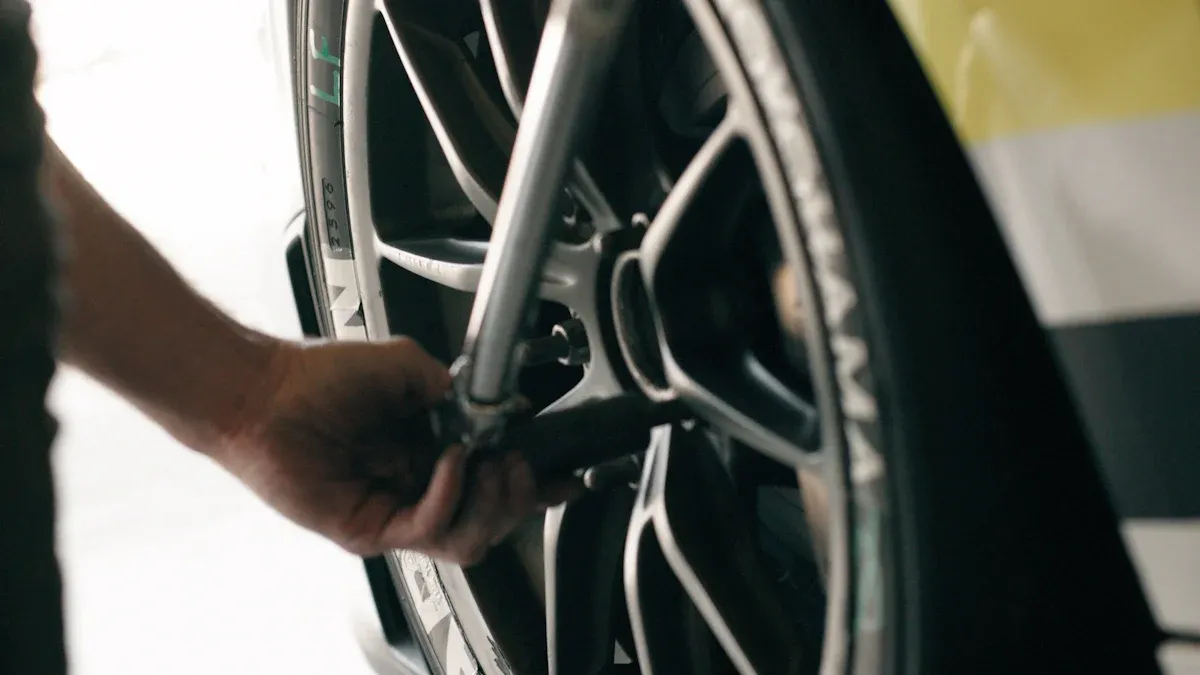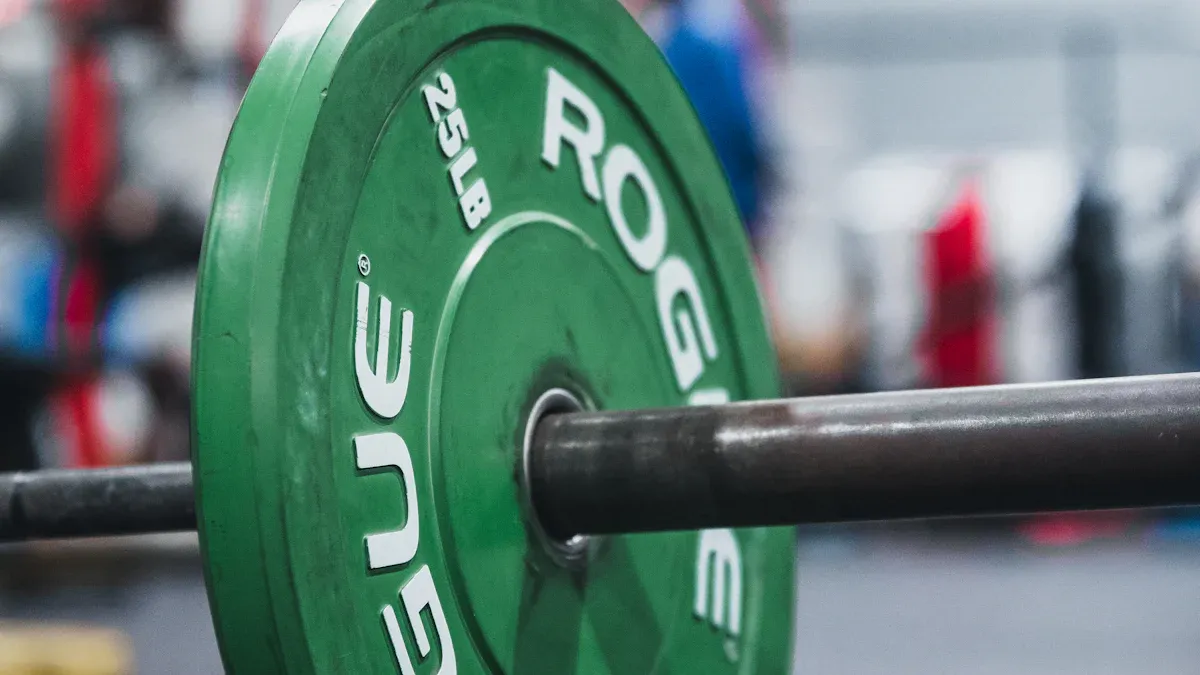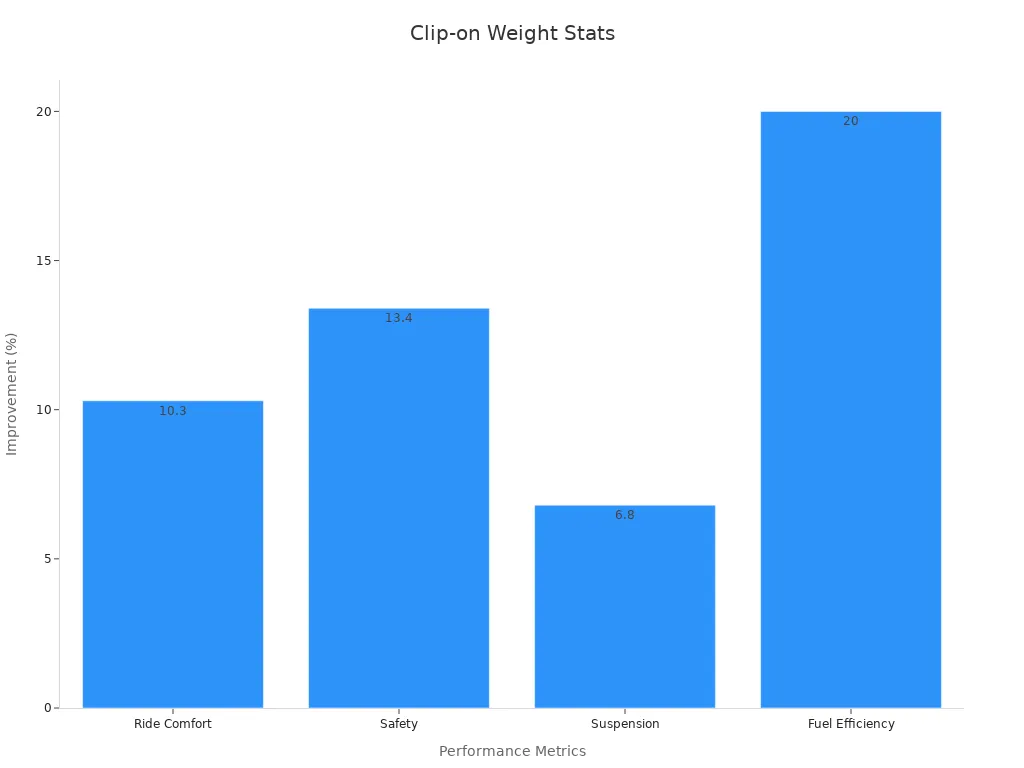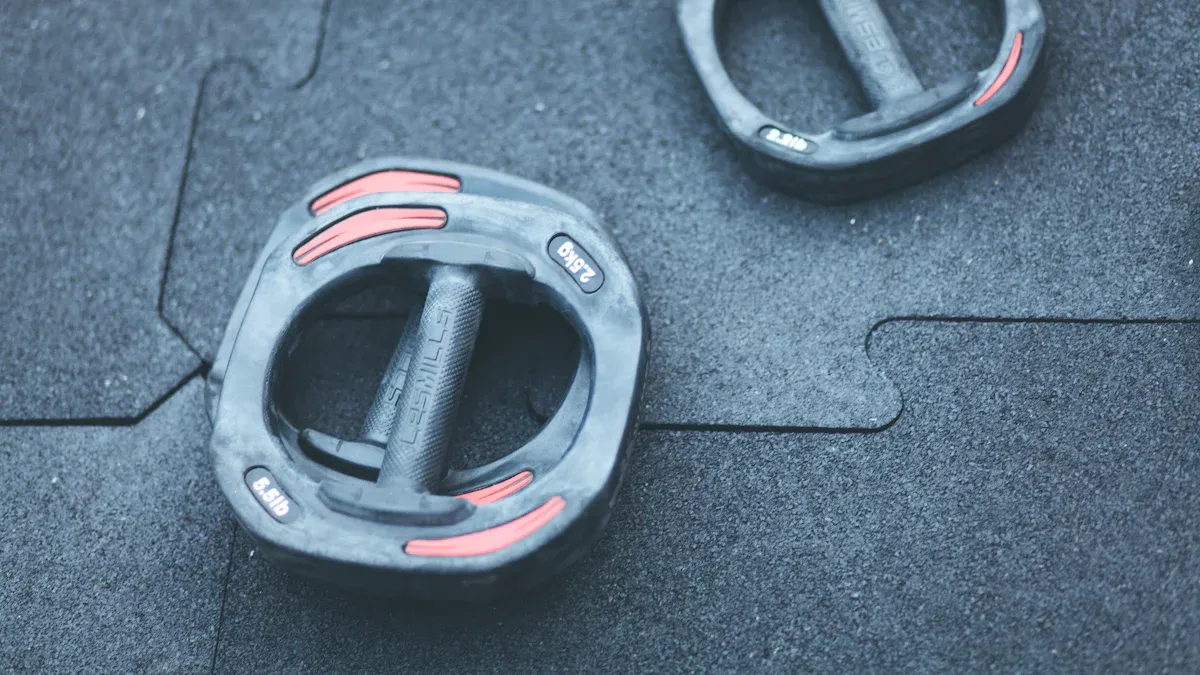

fortuneau
July 5, 2025
Stick On Lead Weights vs Clip-On Weights Pros and Cons Explained

You face an important choice when selecting between stick on lead weights and clip-on weights for your wheels. Each type offers clear strengths. Stick on lead weights give your wheels a clean look and make installation easy, especially for alloy rims. Clip-on weights provide strong attachment and hold up well in tough conditions like rain, heat, and rough roads. You can see key performance impacts in the table below:
| Performance Benefit | Improvement Range |
|---|---|
| Smoother ride | Peak acceleration down by 10.3% |
| Better handling | Lateral body roll down by 13.4% |
| Suspension lifespan | Wear down by 6.8% |
| Fuel efficiency | Up by 2-4% |
Your best choice depends on the type of wheel you have, how you plan to install the weights, and your usual driving conditions.
Stick On Lead Weights Overview
How Stick On Lead Weights Work
You use stick on lead weights to balance your wheels. These weights have a strong adhesive backing. You peel off the protective layer and press the weight onto the inside of the wheel rim. The sticky surface holds the weight firmly in place. Sticky weights wheels help reduce vibration and improve your ride. You do not need special tools to install adhesive wheel weights. You can place them exactly where you need balance. Sticky weights wheels work well on alloy rims because they do not scratch or damage the surface. Many drivers choose adhesive wheel weights for their simple and clean look.
Tip: Always clean the wheel surface before applying sticky weights wheels. This helps the adhesive stick better and last longer.
Typical Applications for Stick On Lead Weights
You will find stick on lead weights used in many modern vehicles. Sticky weights wheels are popular for cars with alloy or custom wheels. These wheels often have limited space or unique shapes. Adhesive wheel weights fit these designs well. You can use sticky weights wheels on sports cars, electric vehicles, and luxury cars. Many shops prefer adhesive wheel weights for their quick installation and neat appearance.
Recent market data shows how drivers around the world use adhesive wheel weights:
| Region | Approximate Market Share | Key Adoption Drivers |
|---|---|---|
| Asia Pacific | ~45% | Rapid automotive growth, rising incomes, vehicle sales, local production, e-commerce, urbanization |
| North America | ~25% | Safety standards, electric vehicle trends, regulations, aftermarket demand |
| Europe | ~20% | Environmental regulations, sustainability focus, innovation, leading manufacturers |
You see that sticky weights wheels are most common in Asia Pacific. This region has fast-growing car markets and many new vehicles. North America and Europe also use adhesive wheel weights, but for different reasons. Safety, new car technology, and environmental rules all play a part. Many drivers now choose stick-on wheel weight options made from non-lead materials, but stick on lead weights remain a trusted choice for reliable wheel balancing.
Clip-On Weights Overview
How Clip-On Weights Work
You use clip-on weights to balance your wheels by attaching them directly to the rim. These weights have a metal clip that grips the edge of the wheel. You place the clip-on wheel weight on the rim and tap it gently with a hammer or special tool. The clip locks onto the wheel, holding the weight in place. This method gives you a secure fit. You do not need glue or adhesives. Clip-on wheel weights work well on steel wheels and some alloy wheels. You can remove and replace them easily if you need to rebalance your tires. Many tire shops use clip-on weights because they save time and offer a strong hold.
Note: Always check that the clip-on weights match your wheel type. Using the right size helps prevent damage and keeps the weight secure.
Typical Applications for Clip-On Weights
You often see clip-on weights used on vehicles with steel wheels. Many trucks, SUVs, and commercial vehicles rely on clip-on wheel weights for their durability. These weights handle rough roads, heavy loads, and changing weather. You can also find clip-on weights on some alloy wheels, especially when the rim design allows for a secure grip.
The market for products like clip-on weights continues to grow. Here are some trends that show why more people choose this type of wheel weight:
- The belt clip market size is estimated at USD 1.5 billion in 2024 and may reach USD 2.8 billion by 2033.
- Experts expect a compound annual growth rate (CAGR) of 7.2% from 2026 to 2033.
- Demand rises due to more wearable accessories, portable electronics, and new uses in law enforcement, healthcare, and retail.
- Outdoor equipment grows at a CAGR of 5.1% (2023-2027), and security and law enforcement industries may grow at 6% (2020-2030).
- Innovations in materials and design make clip-on weights more durable and user-friendly.
- Healthcare, retail, and security sectors increase demand for belt clips, which reflects a broader trend toward using clip-on weights in many industries.
You can see that clip-on wheel weights remain a popular choice for many drivers and industries. Their strong grip, easy installation, and proven reliability make them a trusted solution for wheel balancing.
Stick On Lead Weights vs Clip-On Weights: Key Differences

Compatibility with Wheel Types
You need to match your wheel balancing weights to your wheel type. Stick on lead weights work best with alloy wheels. These wheels often have smooth, flat surfaces inside the rim. You can use adhesive wheel weights on custom wheels or wheels with unusual shapes. The sticky backing lets you place the weight exactly where you need it. You avoid scratching or damaging the wheel finish.
Clip-on weights fit steel wheels very well. Many trucks and older vehicles use steel rims. The clip-on wheel weight grips the edge of the rim tightly. Some alloy wheels also allow you to use clip-on wheel weights, but you must check the rim design. If your wheel has a thick or rounded edge, the clip may not hold as well. Always check your wheel type before choosing a tire wheel balance weight.
Tip: If you have expensive or painted wheels, stick-on wheel weight options help protect the finish.
Installation Process and Ease
You can install adhesive wheel weights quickly. You peel off the backing and press the weight onto the clean wheel surface. You do not need special tools. This process works well in shops and at home. You can place the weight exactly where you need it for perfect balance.
Clip-on weights need a bit more effort. You must use a hammer or a special tool to tap the weight onto the rim. The clip locks in place, but you must make sure you use the right size for your wheel. If you use the wrong size, the weight may fall off or damage the rim. Many tire shops use clip-on weights because they save time when working with steel wheels.
Here is a quick comparison:
| Feature | Stick On Lead Weights | Clip-On Weights |
|---|---|---|
| Tools Needed | None | Hammer or special tool |
| Placement Flexibility | High | Limited by rim design |
| Risk of Rim Damage | Very low | Possible if not careful |
| Installation Speed | Fast | Fast with experience |
Note: Always clean the wheel before applying adhesive wheel weights. Dirt or grease can make the weight fall off.
Durability and Longevity
You want your wheel balancing weights to last. Stick on lead weights stay in place if you install them on a clean, dry surface. They resist water and road salt, but extreme heat or cold can weaken the adhesive over time. If you drive in harsh weather, check your weights often.
Clip-on weights offer strong durability. The metal clip holds tight even on rough roads. You can trust clip-on weights to stay put through rain, snow, and mud. Many commercial vehicles use clip-on weights for this reason. If you remove your tires often, you may need to replace the clip-on weights, as the clip can wear out.
Both types of weights help keep your wheels balanced and your ride smooth. You should choose the type that matches your wheel and driving needs.
Reminder: Inspect your wheel weights during regular tire checks. Replace any weight that looks loose or damaged.
Aesthetics and Appearance
When you look at your wheels, you want them to look clean and stylish. The type of wheel weight you choose can change how your wheels appear. Stick on weights sit on the inside of the rim. You do not see them from the outside. This gives your wheels a smooth and neat look. Many car owners with alloy wheels prefer this hidden style. You keep the original design of your wheels without any metal showing.
Clip-on weights attach to the edge of the rim. You can often see them when you look at the wheel. Some drivers do not mind this, but others want a cleaner look. If you have custom or painted wheels, you may notice the clip-on weights more. The metal clips can stand out, especially on shiny or dark rims.
If you care about the appearance of your wheels, you may want to choose stick on weights for a hidden finish. Clip-on weights work well for drivers who focus more on function than looks.
Here is a quick comparison to help you decide:
| Feature | Stick On Weights | Clip-On Weights |
|---|---|---|
| Visible from outside | No | Yes |
| Best for custom wheels | Yes | Sometimes |
| Risk of scratching | No | Possible |
| Matches wheel color | Yes | No |
You should think about how much you care about the look of your wheels. If you want a factory-fresh style, stick on weights may be your best choice. If you do not mind seeing the weights, clip-on weights offer a classic and practical solution.
Cost Considerations
You want to balance your wheels without spending too much. The cost of wheel weights depends on the type you choose and the kind of wheels you have. Stick on weights often cost a bit more than clip-on weights. The adhesive backing and special design for alloy wheels can raise the price. You may also need to buy extra cleaning supplies to make sure the surface is ready for the adhesive.
Clip-on weights usually cost less per piece. Tire shops often use clip-on weights for steel wheels because they are quick to install and easy to replace. You save money on labor because the process is fast. If you drive a truck or a commercial vehicle, you may use clip-on weights more often. This can lower your long-term costs.
Tip: Always check if your wheels need a special type of weight. Some custom wheels require unique stick on weights, which can cost more. Standard clip-on weights fit most steel wheels and keep costs down.
Here are some points to help you compare costs:
- Stick on weights may cost more up front, but they protect your wheels from scratches.
- Clip-on weights offer a budget-friendly choice for steel wheels and high-mileage vehicles.
- If you change your tires often, clip-on weights make replacements quick and cheap.
- Some shops include the price of clip-on weights in the cost of a tire balance service.
You should ask your tire shop about the total price before you choose. Think about both the cost of the weights and the cost of installation. If you want the best value, match the weight type to your wheel and your driving needs.
Pros and Cons of Stick On Lead Weights
Advantages of Stick On Lead Weights
You get many benefits when you use sticky weights wheels. These weights give you a clean look because you place them on the inside of the rim. You do not see them from the outside. This helps your wheels look smooth and stylish. Sticky weights wheels work well with alloy wheels and custom rims. You avoid scratches or marks on your wheel surface.
You can install sticky weights wheels easily. You do not need special tools. You just peel and stick. This saves you time in the shop or at home. Sticky weights wheels let you place the weight exactly where you need it for perfect balance. You get a smoother ride and less vibration.
Tip: Sticky weights wheels help protect painted or polished rims. You keep your wheels looking new for longer.
Here is a quick list of advantages:
- Hidden from view for better appearance
- Easy and fast to install
- No risk of scratching the rim
- Good for alloy and custom wheels
- Flexible placement for precise balance
Disadvantages of Stick On Lead Weights
You should also know the limits of stick on lead weights. The adhesive on sticky weights wheels needs a clean, dry surface. If you do not clean the wheel well, the weight may not stick. Extreme heat or cold can weaken the glue over time. You may need to check sticky weights wheels more often if you drive in harsh weather.
Sticky weights wheels may cost a bit more than other types. You might need extra cleaning supplies before you install them. If you remove the weights, you may see some sticky residue left behind.
| Disadvantage | Impact on Use |
|---|---|
| Needs clean surface | May fall off if dirty |
| Sensitive to temperature | Adhesive can weaken |
| Slightly higher cost | More expensive than clips |
| Possible residue | May need extra cleaning |
Remember: Always check your sticky weights wheels during regular tire checks. Replace any that look loose or damaged.
Pros and Cons of Clip-On Weights
Advantages of Clip-On Weights
You get strong benefits when you use clip-on weights for your wheels. These weights attach firmly to the rim, so you do not worry about them falling off during rough drives. You can count on clip-on weights to handle tough roads, heavy loads, and high speeds. Many drivers choose them for trucks, SUVs, and steel wheels because they last a long time.
Clip-on weights help your car ride smoother. They reduce peak vertical acceleration by 10.3%. This means you feel fewer bumps and shakes. You also get better control in sharp turns, as clip-on weights lower lateral body roll by 13.4%. Your suspension parts last longer because these weights cut down wear by 6.8%. You may even save up to 20% on fuel because balanced wheels roll easier.
Here is a table that shows how clip-on weights perform:
| Feature/Statistic | Clip-on Weights Benefit |
|---|---|
| Durability | High; handles rough terrain and high speeds |
| Fatigue Resistance | Up to 217,000 cycles for long-term use |
| Best for | Steel wheels, trucks, SUVs |
| Ride Comfort | Reduces bumps by 10.3% |
| Safety in Turns | Lowers body roll by 13.4% |
| Suspension Wear | Decreases by 6.8% |
| Fuel Efficiency | Can improve by up to 20% |

Tip: You can install clip-on weights quickly with the right tool. This makes them a favorite in busy tire shops.
Disadvantages of Clip-On Weights
You should know some limits of clip-on weights. These weights need a rim with the right shape. If your wheel edge is too thick or rounded, the clip may not grip well. You may see clip-on weights from the outside, which can affect the look of your wheels. Some drivers do not like the visible metal clips, especially on custom or painted rims.
You must use a hammer or special tool to install clip-on weights. If you do not use the right size or tool, you might damage the rim or the weight may not stay secure. Clip-on weights work best on steel wheels. They may not fit all alloy wheels.
Here are some points to remember:
- Needs correct rim shape for secure fit
- Can be visible on the wheel edge
- Requires tools for installation
- May not suit all alloy wheels
Note: Always check your wheels before choosing clip-on weights. Make sure the rim matches the weight for the best results.
Choosing the Right Wheel Weight for Your Needs

Wheel Material Considerations (Alloy vs Steel)
You need to match your wheel weights to your wheel material. Alloy wheels often have a smooth, painted surface. Stick-on weights work well here because they do not scratch or damage the finish. You can place them inside the rim, keeping your wheels looking clean. Clip-on weights can fit some alloy wheels, but you must check if the rim edge allows a secure grip. Steel wheels are common on trucks and older cars. Clip-on weights attach tightly to steel rims. You get a strong hold, which is important for heavy vehicles. If you want to protect your alloy wheels, stick-on weights are a good choice. For steel wheels, clip-on weights give you reliable performance.
Tip: Always check your wheel type before choosing weights. Using the right weight helps you achieve proper wheel balance and keeps your wheels in good shape.
Driving Conditions and Environment
Your driving habits and environment affect how your wheel weights perform. If you drive on rough roads or in bad weather, you need weights that stay secure. Clip-on weights handle bumps, mud, and rain very well. They grip the rim and resist coming loose. If you drive mostly in the city or on smooth roads, stick-on weights can last a long time.
Studies show that driving conditions like speed, braking, and vehicle weight change how much material your wheels lose. When you brake hard, your wheels and brakes release more particles. This means your wheel weights may wear out faster. The table below shows how different factors affect wheel weight performance:
| Driving Condition Factor | Impact on Wheel Weight Performance (Emissions) | Numerical Evidence / Emission Factors (EFs) |
|---|---|---|
| Vehicle Velocity | Higher speed lowers brake and tire wear emissions | EMEP/EEA model: PM2.5 and PM10 EFs decrease as speed increases |
| Vehicle Weight | Heavier vehicles increase wear and emissions | Heavy-duty trucks have higher EFs than light vehicles |
| Braking Intensity | More braking raises particle emissions | Braking conditions increase brake wear PM emissions |
| Road Type | Different roads change emission profiles | Highways and urban roads show different EFs |
You should think about your daily routes. If you drive a heavy vehicle or brake often, clip-on weights may last longer. For light cars and gentle driving, stick-on weights can work well.
Personal Preferences and Priorities
Your own needs matter when you pick wheel weights. If you care about how your wheels look, stick-on weights hide inside the rim. You keep a clean, smooth style. If you want fast service and easy replacement, clip-on weights are a smart pick. Tire shops can install them quickly, which helps if you need a fast tire balance.
Some drivers want the lowest cost. Clip-on weights usually cost less, especially for steel wheels. Others want to protect custom or painted rims. Stick-on weights help you avoid scratches. You should also think about how often you change tires. If you swap tires often, clip-on weights make the process simple.
Note: Your choice depends on what matters most to you—looks, cost, ease of use, or durability. Both stick-on and clip-on weights help you achieve good tire balance and smooth driving.
Fortune’s Commitment to Quality in Wheel Weights
Manufacturing Standards and Certifications
You want wheel weights that meet the highest standards. Fortune takes quality seriously at every step. The company holds the ISO9001 certification. This means you get products made under strict quality management systems. Every process, from raw material selection to final inspection, follows international guidelines.
Fortune never uses inferior materials. You can trust that each wheel weight comes from carefully sourced metals. The company tests every batch before shipment. In fact, Fortune checks 233% of products before they leave the factory. This extra testing helps catch any issues early.
Note: ISO9001 certification shows that Fortune meets global standards for quality. You get peace of mind knowing your wheel weights come from a certified manufacturer.
Here is a quick look at Fortune’s quality steps:
| Step in Production | Quality Action Taken |
|---|---|
| Material Selection | Only premium metals used |
| Manufacturing | Automated, precise processes |
| Inspection | Multiple checks per product |
| Packaging | In-line accuracy checks |
| Pre-shipment | Final quantity and quality review |
Product Quality and Customer Support
You deserve products that last and a team that supports you. Fortune’s engineers design and test every wheel weight for durability and performance. The company uses advanced automation to keep quality high and production efficient. You benefit from products that work well on all types of wheels.
If you have questions or need help, Fortune’s customer support team responds quickly. The company set up warehouses and offices in North America to help you get products faster. You can reach out for technical advice, order support, or product information.
Tip: Fortune’s team attends international auto parts shows every year. This helps them stay updated and ready to meet your needs.
You get more than just a product. You get a partner who cares about your satisfaction and safety. Fortune’s commitment to quality and support helps you drive with confidence.
You want the best tire balance for your vehicle. Stick-on wheel weights work well for alloy wheels and city driving, giving you a clean look and smooth ride. Clip-on weights fit steel wheels and handle rough roads, offering strong durability. See the table below for a quick comparison:
| Feature | Stick-On Weights | Clip-On Weights |
|---|---|---|
| Best for | Alloy wheels, urban | Steel wheels, off-road |
| Installation | Adhesive, clean rim | Clip, needs tool |
| Durability | Needs maintenance | Very secure |
- Choose stick-on weights for style and smooth roads.
- Pick clip-on weights for tough conditions and heavy use.
- Always use quality products for proper wheel balance and long-lasting tire balance.
Fortune’s strict standards help you achieve reliable tire balance every time.
FAQ
What is the main difference between stick-on and clip-on wheel weights?
Stick-on weights use adhesive to attach inside the rim. Clip-on weights use a metal clip to grip the rim edge. You choose stick-on for a hidden look on alloy wheels. You pick clip-on for a strong hold on steel wheels.
Can I reuse wheel weights after removing them?
You should not reuse wheel weights. The adhesive on stick-on weights loses strength after removal. Clip-on weights may bend or lose grip. Always use new weights for safe and accurate wheel balancing.
Do wheel weights affect my car’s fuel efficiency?
Yes, balanced wheels help your car roll smoothly. You use less energy and fuel. Studies show balanced wheels can improve fuel efficiency by 2–4%. You also protect your suspension and tires from extra wear.
How do I know if my wheel weights need replacing?
Look for missing, loose, or damaged weights during tire checks. If you feel vibration or shaking while driving, your wheels may need rebalancing. Always replace any weight that does not stay secure.





